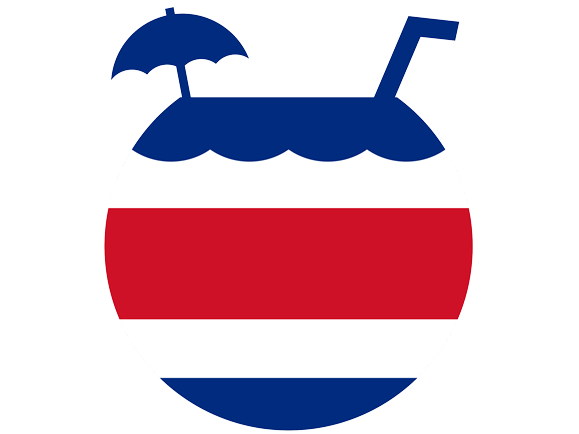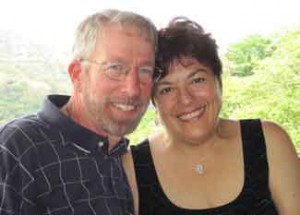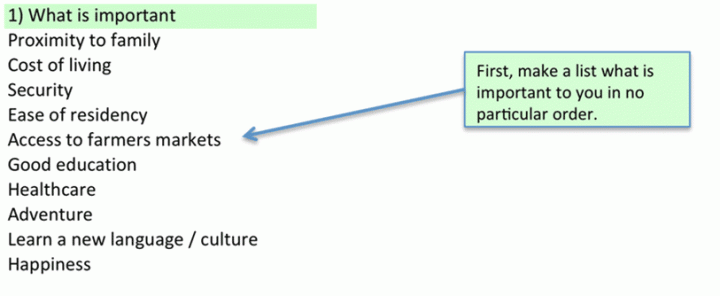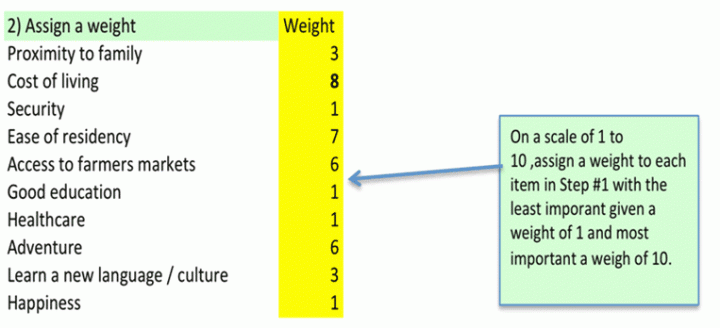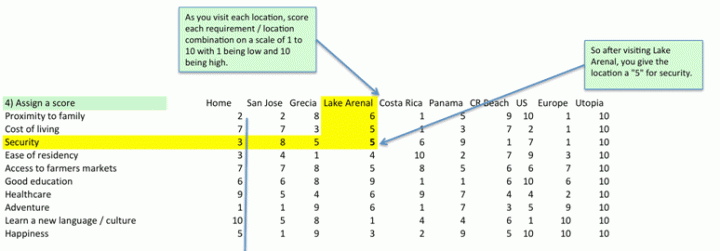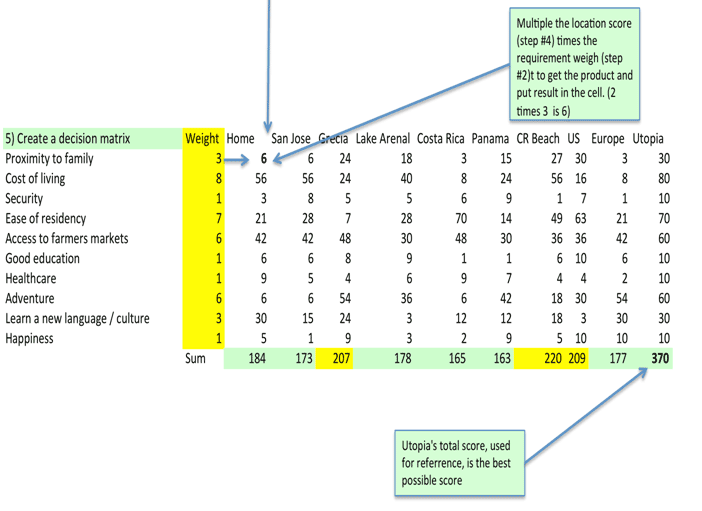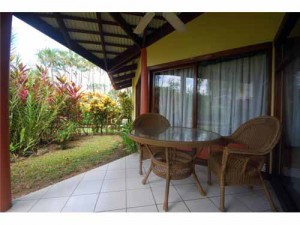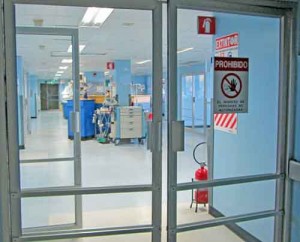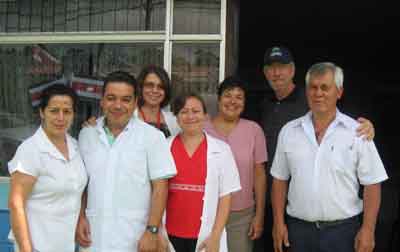Moving to CR, Life in CR
Retire for Less in Costa Rica – February 20, 2016
Welcome to our Retire For Less In Costa Rica Newsletter
In This Issue:
- Where Should You Retire? Here’s a Tool to Help You Decide, by Rob Evans
- 9 Tips to Find Your “Perfect Place” in Costa Rica
- Due Diligence–Our Take on It
- Featured Property: Jaco Beach-1BR Villa in Downtown Jaco $129,000
- Our Ultimate CR Healthcare Tour
Where Should You Retire? Here’s a Tool to Help You Decide
I often see folks posting questions about where to move when they retire. They may be trying to decide between Costa Rica and Ecuador or between different cities in Costa Rica, not knowing which location is right for them or even how to begin to make the decision. I appreciate the difficulty and had similar challenges deciding where to spend my retirement. Fortunately, I have an understanding of decision theory that I used to break the impasse.
 The essence of making a good decision is to take emotion out of the equation and to make a dispassionate, mathematical analysis of priorities and options. When making your analysis, do not overthink what you are doing. In other words, DO put some thought into the numbers when listing and ranking priorities, but DO NOT think ahead to where the analysis is leading. Otherwise, you may subconsciously skew the numbers to get the outcome you think you want or you think your spouse wants. After the first pass, you may adjust some numbers to get the other results, but at least you will know what you are doing.
The essence of making a good decision is to take emotion out of the equation and to make a dispassionate, mathematical analysis of priorities and options. When making your analysis, do not overthink what you are doing. In other words, DO put some thought into the numbers when listing and ranking priorities, but DO NOT think ahead to where the analysis is leading. Otherwise, you may subconsciously skew the numbers to get the outcome you think you want or you think your spouse wants. After the first pass, you may adjust some numbers to get the other results, but at least you will know what you are doing.
So, DO NOT read ahead. Begin with step one and cover up the next steps, following them in order; otherwise, you will subconsciously manipulate the outcome. I suggest partners first do this exercise individually, compare results, discuss what you learned, and then do the entire exercise together for the second pass.
Step 1: What is Important?
Make a list of all the things that are important to you. Start by making the list 10 items long. Here are some suggestions to get you started, though your list may vary greatly depending on your family status, wealth and age:
Step 2: Assign a weight to each item.
After making your list, assign a weight number to indicate the relative importance of each item. Those things of average importance might be assigned a 5, while the most important may have a weight of 7 or 8. You are not ranking them in order from 1-10; rather, you are assigning weight to their importance. Some items may have the same weight, but do try to use the ends of the scale as much as possible and not make everything a 5.
Step 3: List the locations you are considering.
List the locations you are considering. They might be countries or cities. It does not matter; just put them on a piece of paper or spreadsheet. This might be the point at which your spouse says she will never move to Africa, no matter how exciting and cheap it would be, which would allow you to eliminate it from the list of potential retirement places. Also, include where you live now (Home) and your ideal (Utopia) as reference points because I find people often really love where they live now and simply need a vacation, not a change in residence. I include Utopia, as the last column to keep me grounded on what perfection would look like.
Step 4: Visit your location choices and score each location on how well it meets your requirements.
Time for some fieldwork. Visit each place you are considering with an open and observant eye. Quickly, score each location on a scale of 1 to 10 (low to high) for each requirement on your list. If your child’s education is on the list and the place you are considering has poor schools, you need to score it low (2 or 3). If quick access to the US is on the list and the place has an international airport, you would give it a high score (8 or 9). Again, do not think long and hard about this, just score things. There is nothing permanent about the score that an eraser won’t fix.
Step 5: Create a decision matrix.
Now, multiply the location score by the requirement weight and put it in the cell in the decision matrix. In the example below, the person assigned a weight of 3 (not very important at this time) to “Proximity to family”. Separately, he rated his present HOME as a 2 (a hard place to keep in contact with family). He then multiplied the weight of the requirement (3) times the score for the location (2) and gets a product of 6 for Home’s “Proximity to family.”
After you multiply all of the scores for each location by their requirement weights, completing the product matrix, the final step is to add up all the numbers for each location. Below you see Home gets a score of 184 and Utopia gets a score of 370.
These numbers give you a measurable method to help you rank the various options you are considering.
Now that you have the results, you are going to be excited, surprised, sad, and bewildered. You had your heart set on moving to Costa Rica but may have discovered that where you live now, next to your grandkids, is what makes you happy. Maybe the right decision is to keep your current home and take the grandkids to Costa Rica for a vacation. I hope this gives you another tool to help you decide if moving to Costa Rica is right for you and your family.
More Articles by Rob Evans:
- What Does It Cost You NOT to Move to Costa Rica? by Rob Evans
- The Best Way to Live for Less in Costa Rica (or Anywhere), by Rob Evans
- Our Costa Rica Healthcare Plan, by Rob and Jeni Evans
 9 Tips to Find Your “Perfect Place” in Costa Rica
9 Tips to Find Your “Perfect Place” in Costa Rica
Okay, you’ve visited Costa Rica a couple of times, read everything you can get your hands on, and you’ve decided to retire here. The reality of such a big move hits you, and you want to make sure that every decision along the way is the right one for you. I don’t blame you. San Ramon turned out to be “just right” for us, but where is your “just right” place? When it comes to picking the right town in Costa Rica to settle in, we have a few tips for you.
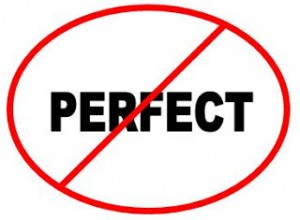 First, know that there is no “perfect place.” Anywhere you choose to live will require some compromises, either on the weather, or the size of the town, or something. We lived at the cabinas at 4,000 ft. elevation for almost 4 years and wished that we were about 500 ft. lower in elevation because it wouldn’t be as cool. Now we’re living in Magallanes at 3,000 ft. elevation and I wish we were 500 feet higher because it can really be warm some afternoons! That being said, we love where we’re living, just as we loved living at the cabinas. If you don’t demand perfection and try to live each day with a very pura vida attitude, you’ll be much happier here.
First, know that there is no “perfect place.” Anywhere you choose to live will require some compromises, either on the weather, or the size of the town, or something. We lived at the cabinas at 4,000 ft. elevation for almost 4 years and wished that we were about 500 ft. lower in elevation because it wouldn’t be as cool. Now we’re living in Magallanes at 3,000 ft. elevation and I wish we were 500 feet higher because it can really be warm some afternoons! That being said, we love where we’re living, just as we loved living at the cabinas. If you don’t demand perfection and try to live each day with a very pura vida attitude, you’ll be much happier here.- Rent before you buy (or even forever!) The good thing about renting is that you aren’t tied into one place. We think it’s a great idea to just come, land somewhere, and then explore the other areas you are interested in. What is “spring-like” to one person is chilly (or too warm) to another person, so you need to experience it yourself to see if it would work for you. But that’s all part of the adventure!
 As a corollary to #2 above, if possible, do not ship everything you own right away (or maybe ever). Try to rent furnished houses or apartments at first. Once you have shipped a container of possessions, it becomes harder to be mobile; it’s more of a hassle to move to another house or town if you don’t love the one you’re in.
As a corollary to #2 above, if possible, do not ship everything you own right away (or maybe ever). Try to rent furnished houses or apartments at first. Once you have shipped a container of possessions, it becomes harder to be mobile; it’s more of a hassle to move to another house or town if you don’t love the one you’re in.- Experience Costa Rica in both the dry season and rainy season before you decide where to settle down. Late September into October is the rainiest time on the Pacific side of the country, but in the dry season, by March and April, things can be looking pretty brown here. The Caribbean side of the country has different weather patterns, with no extended dry season and rain at times throughout the year. You should experience both to see how you like it and how your body responds. Allergies can crop up for people during different times of the year (while other people find that their existing allergies go away once they move here).
- Maybe you want the conveniences of a larger town but want to live in a small town where you can know your neighbors and get involved with the community. Consider living in one of the many smaller communities that surround the larger town you’re interested in. That way you could get the benefits of small town life along with nearby conveniences.
- Remember that there are many micro-climates in Costa Rica
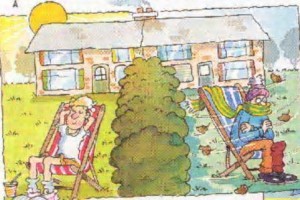 . Sometimes you can be in the same general location but up on a hill or down in a more protected area and there can be a 5 degree difference in temperature. It might be windier if you are on top of a hill and not so windy if your house is up against the side of a hill. There are so many variables that it’s hard to generalize. Again, you just have to experience it for yourself.
. Sometimes you can be in the same general location but up on a hill or down in a more protected area and there can be a 5 degree difference in temperature. It might be windier if you are on top of a hill and not so windy if your house is up against the side of a hill. There are so many variables that it’s hard to generalize. Again, you just have to experience it for yourself. - Maybe you’ve always wanted to live at the beach but you can’t stand the heat day after day, and air conditioning is expensive! Consider living at a higher elevation near the beach area in which you are interested. When we selected San Ramon, we liked the cooler temperatures, but also the fact that we can be at the beach in less than an hour. We wanted to live in a place where we didn’t need heat or air conditioning and where we could keep our doors and windows open during the day. If you choose to live at the beach – which many people do – just know that you either need to be extremely tolerant of the heat or live in air conditioning (and pay high electric bills) for at least part of the day.
- Finding a great place to live is a very personal choice. If you haven’t done so already, make a list of what’s important to you in terms of access to the kinds of activities you like, climate, type of neighborhood, distance to attractions or shopping, etc. Our friend, George Lundquist, provides such a checklist to people who take his tour. If you would like more information about George’s Retire in Costa Rica on Social Security Tour and to receive his checklist, just fill out the contact form here.
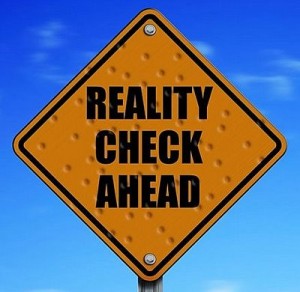 Your ideas about where you want to live and thereality of living there may turn out to be very different. Living out in the country may sound like a good idea but you might find you miss having neighbors close by, and the long trek into town to buy necessities could get old. Or, you might like the stimulation of living in town, with the ability to walk most places, but you find that you really want to be around more green and less noise. Maybe you are convinced that you want a top-of-the-mountain view, but you later find that the accompanying winds that come with being so exposed dampen your pleasure. I know that some aspects of our “perfect place” have changed over time (but after four years, we’re pretty darn close). There are many trade-offs you may need to make that you can’t even conceive of until you are actually living here.
Your ideas about where you want to live and thereality of living there may turn out to be very different. Living out in the country may sound like a good idea but you might find you miss having neighbors close by, and the long trek into town to buy necessities could get old. Or, you might like the stimulation of living in town, with the ability to walk most places, but you find that you really want to be around more green and less noise. Maybe you are convinced that you want a top-of-the-mountain view, but you later find that the accompanying winds that come with being so exposed dampen your pleasure. I know that some aspects of our “perfect place” have changed over time (but after four years, we’re pretty darn close). There are many trade-offs you may need to make that you can’t even conceive of until you are actually living here.
So bottom line, when trying to find your “perfect place,” do your homework, make a preliminary, educated decision about where to land, and jump in! You don’t have to get it right the first time. Living here is different from visiting here, and there is only so much you can figure out ahead of time. Part of the adventure is getting to know this beautiful country first-hand and to discover what’s right for you.
Related Articles:
- Why We Chose Nuevo Arenal, by Janet Bradshaw
- Why I Chose to Live in Heredia City, by Joe Tursi
- The 6 Reasons Why We Still Choose San Ramon
- Why I Chose Puriscal, by Linda Stevener
- The Central Valley Town of Grecia
Due Diligence – Our Take on It
We were having a nice lunch at the home of new friends and recent expats to Costa Rica, Janet and Don Morley when the conversation got interesting. “Repeat what you just said,” Don said to Paul, “and this time on camera.” So we talked and Don recorded the following video (and gave us permission to use it).
Lots of folks place a lot of emphasis on “due diligence” while, from what we’ve seen, that doesn’t always guarantee success of one’s move to another country. It’s not that we are against “due diligence.” It’s just that some of the folks we’ve met who have done the most “due diligence” are the ones who have returned home for one reason or another; and others who did very little research ahead of time are extremely happy living in Costa Rica. So, here are some of our thoughts about the topic. Let us know what you think.
Due Diligence – Our Take on It
Featured Property: Jaco Beach-1BR Villa in Downtown Jaco-$129,000
Price:$129,000
Total Rooms: 3
# Bedrooms: 1
# Bathrooms: 1
Total SqM: 63
Description:
This beautiful villa is located at Jaco downtown.
It features: 1 bedrooms, a/c, walk in closet, 1 bathroom, 1 living room, fully equipped kitchen, parking space. Beautiful gardens around the terrace.
This community is surrounded by exotic green areas, a large common pool, bbq area, rancho and 24 security.
Just a few steps from the beach, shopping, and restaurants.
Click here for more photos and information and to contact the realtor for this property.
Click here to check out our other properties under $150,000 and read about what to do before you buy.
![]()
Our Ultimate Healthcare Tour of Costa Rica
Our newest tour is the Ultimate Healthcare Tour of Costa Rica. When asked what he liked best about our healthcare tour, one of our guests wrote, “the wide variety of places we saw, the experts that Paul  arranged for us to meet and talk with, and an emphasis on all aspects of health, not just doctors and hospitals. Mental health is just as important as physical, if not more so.”
arranged for us to meet and talk with, and an emphasis on all aspects of health, not just doctors and hospitals. Mental health is just as important as physical, if not more so.”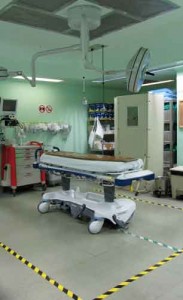
We’ve lived in Costa Rica for over six and a half years and have used the Caja, Costa Rica’s public healthcare system extensively, as well as the private system, when needed. We’ve learned the system and have been referred up the ladder to see specialists in the maze that is the Caja system. Gloria’s even had surgery here.
Our blend of personal insights and on-the-ground experience combines to answer your questions about whether or not Costa Rica’s healthcare system could meet your individual needs.
But, while it is focused on healthcare, you will learn a lot more about living and retiring in Costa Rica’s Central Valley. Most of the second day of the tour takes place in the town of San Ramón where we live and use the services. And you will come to our home for lunch that day to listen to two of our featured speakers.
Our tour is designed to save you both time and money, packing a lot of information into a short period of time. Our goal is to show you the possibilities and to try to demystify Costa Rica’s healthcare system. Our tour lasts two days and 1 night and includes lodging, transportation, meals and non-alcoholic beverages.
Sample Itinerary
You’ll visit:
- At least two private hospitals in San Jose area
- Hospital Mexico, the largest and best public hospital (they even do open heart surgeries there)
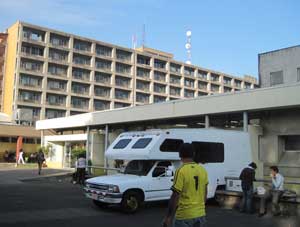
- An insurance broker for a presentation on the various supplemental health insurance options, including public, private, and international plans
- A senior living retirement community
- CPI language school for a presentation about how learning Spanish increases your options for healthcare and some basic medical Spanish.
- Our local hospital here in San Ramón
- A local EBAIS (community clinic)
- A local private medical and dental clinic
- A local Seguro Social office where you would sign up for the Caja (national healthcare coverage)
- A pharmacy
- A health food store (macrobiotica), and more!
You’ll learn:
- If the Costa Rican healthcare system could meet your needs and put your mind to rest, once and for all, about this sensitive subject.
- About the public system and how it works, about the private healthcare system, and how you can use a combination of both to your advantage.
- About the EBAIS – where healthcare starts in Costa Rica.
- Approximately how much you would pay for Caja.
- About medical tourism in Costa Rica.
- About home health care in Costa Rica.
Introductory prices: $550 for a couple, $450 for a single.
Please contact us if you are interested in booking this tour. Space is limited.
Related Articles:
- Paul Gets a CAT Scan Through the Caja
- Integration 102 – Speaking Up at the Hospital
- Waiting to See the Doctor, by Jo Stuart
 Facebook, Twitter, & YouTube
Facebook, Twitter, & YouTube
![]()
![]()
![]() You can now follow us on Facebook and Twitter, so please “like” us on Facebook, “follow” us on Twitter, and watch and share our videos on YouTube.
You can now follow us on Facebook and Twitter, so please “like” us on Facebook, “follow” us on Twitter, and watch and share our videos on YouTube.
 What’s New on the Website
What’s New on the Website
Check out our newest posts on www.retireforlessincostarica.com:
- Gardening in Costa Rica with Steve – Gardening for Wildlife
- Gardening in Costa Rica with Steve – Q & A
- Monthly Costa Rica Weather Report for 9 Towns in Costa Rica – December 2015
- Our December 2015 Costa Rica Cost of Living Expenses
- Journey to the “Dark Side” of Costa Rica: A visit to Puerto Viejo, Costa Rica, by Bonnie Vining
- Buying Organic Produce in Costa Rica
- Due Diligence – Our Take on It
- In the Mailbag: Residency in Costa Rica and Buying a Car
